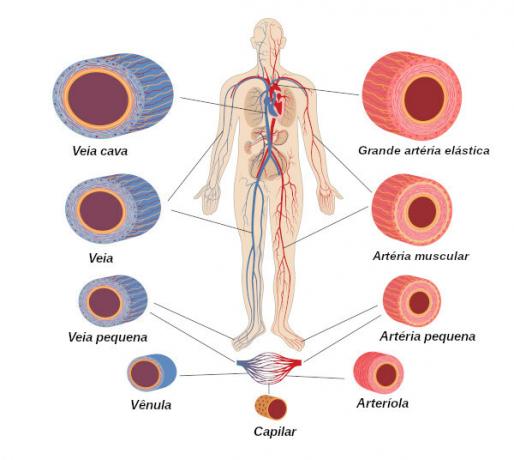arteries are blood vessels that promote the transport of blood of heart for the fabrics. In arteries, the blood is under high pressure and, for this reason, these blood vessels have very resistant walls. Unlike what many people think, arteries do not only carry oxygen-rich blood (arterial blood), the transport of oxygen-poor blood (venous blood) in the pulmonary artery being observed.
Arteries can be classified into large elastic arteries, muscular arteries and arterioles. Atherosclerosis, aortic aneurysm and stroke are health problems caused by arterial problems.
Read too: Difference between vein, artery and capillary
General characteristics of the arteries
Arteries are blood vessels that have thick, resistant walls to support the high-pressure blood flowing through them. The function of these vessels is allow the blood that leaves the heart to be carried to the different tissues of the body. At pulmonary circulation, the arteries are responsible for carrying blood to the lung so that it can be oxygenated; at
systemic circulation, the arteries ensure that oxygenated blood is taken to the most varied parts of the body.
Arteries have walls formed by three layers, known as tunics.
Underwear: layer located more internally. It is made up of endothelial cells that rest on the subendothelial layer, which is made up of loose connective tissue. Between the tunica intima and the tunica media, it is possible to observe a sheet composed mainly of elastin.
Middle tunic: it is the middle layer of the wall of the arteries. It is mainly made up of unstriated muscle tissue.
Adventitious tunic: it is the outermost layer and is continuous with the connective tissue present in the organ through which the artery is passing. This layer is mainly formed by elastic fibers and collagen.
Do not stop now... There's more after the advertising ;)
Classification of arteries
Arteries can be classified according to their diameter in elastic arteries, muscular arteries and arterioles. Let's see below the main characteristics of each one of them.

large elastic arteries
In this group we have the aorta and its branches as an example. They are large-caliber arteries that stand out for the presence of a tunica media with a large amount of elastin, which gives them a characteristic yellowish color. The presence of elastic laminae allows blood flow to be more uniform, reducing pressure variations during systole and diastole.
Medium diameter arteries or muscular arteries
These arteries have a medium diameter and, unlike the large elastic arteries, they have a tunica media basically made up of muscle cells. Contraction of these cells allows muscle arteries to control blood flow to the organs.
arterioles
Arterioles have a small diameter compared to large arteries and muscular arteries. They usually have a diameter of less than 0.5 mm.
Read too: Aorta - the largest and main artery in our body
Blood pressure
Blood pressureit is the pressure that the blood puts on the wall of the arteries. It is greater at the time of ventricular systole, that is, at the time the ventricle contracts, being known as systolic pressure. At the time of diastole, when the ventricles are relaxed, we have a lower blood pressure, which is known as diastolic pressure.
In a young adult at rest, it is common for normal blood pressure to be around 120 millimeters of mercury in systole and 80 millimeters of mercury in diastole, this pressure being expressed as 120/80 (12 per 8).
THE hypertensionor high blood pressure it is a situation in which high blood pressure values are observed. According to the Ministry of Health, it happens when the maximum and minimum pressure values are equal to or exceed 140/90 mmHg (or 14 by 9). High blood pressure can be potentially dangerous, being related to problems such as heart attack, stroke and kidney failure.
Health problems caused by compromised arteries
Arteries are blood vessels that ensure the transport of blood to the fabrics and organs in our body. Some situations, such as the reduction of the caliber of these vessels, dilation of the arteries and even their rupture, can cause serious damage to our health. Here are three health problems that are directly related to the arteries.

Atherosclerosis or atherosclerotic disease: problem that affects the arteries of the body and is characterized by the deposition of fat, calcium and other elements in the wall of these blood vessels, forming plaques called atheromas. This deposition occurs slowly and initially causes no symptoms. As the disease progresses, however, the caliber of the arteries becomes reduced, which impedes the supply of blood to the part of the body that is supplied by that artery. You atherosclerosis symptoms dependm of the artery that is being affected. When it compromises the arteries of the heart, for example, it can cause angina (chest pain). There are several risk factors for the development of atherosclerosis, some of them being high levels of lipids in the blood (dyslipidemia) and hypertension.
Aortic aneurysm: it is a problem that affects the aorta artery, causing a dilation in that artery. Factors such as aging and smoking are related to the development of aortic aneurysm. This aneurysm can develop without causing symptoms and is often diagnosed in routine exams. This is a serious problem, as the aneurysm can rupture, causing a drop in pressure and hemorrhagic shock.
Accident vascular çerebral (stroke): Stroke occurs when some area of the brain does not receive blood properly. This problem can occur as a result of the rupture of an artery or even its blockage. When an artery in the brain region is blocked, preventing blood flow, we have the so-called ischemic stroke. When the artery ruptures, we have the call hemorrhagic stroke. Tingling on the face, speech and vision changes, balance change, dizziness, weakness and sudden headache are symptoms that can appear in cases of stroke. Risk factors for the development of the problem are hypertension, high cholesterol, smoking and advanced age.
By Vanessa Sardinha dos Santos
Biology teacher
Would you like to reference this text in a school or academic work? Look:
SANTOS, Vanessa Sardinha dos. "Arteries"; Brazil School. Available in: https://brasilescola.uol.com.br/biologia/arterias.htm. Accessed on June 27, 2021.



